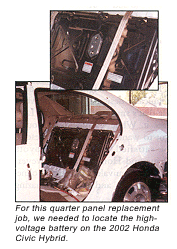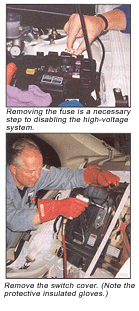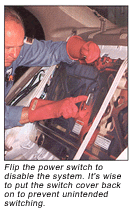Fuel costs – gasoline or diesel – seem to be creeping ever higher.
This is probably natural because of the rules of supply and demand. Oil is a finite resource, and as we use more of our own American crude in the lower 48, we’re going further afield to supply our ever-expanding need for more fossil fuel.
But exploration is expensive, and the transmission of newly discovered oil is fraught with tremendous cost and ever-increasing environmental concerns. Just getting the oil to the refinery is a major engineering and financial consideration. And once the crude is refined, it must be transmitted to distribution points, commonly by underground high-pressure pipeline.
Sure, there are megabucks in this scenario, but there are also mega problems and big exposure to ongoing litigation and liability costs. A high-pressure underground pipeline in the region where I live ruptured last year and filled a river with gasoline. Fumes in the huge area affected were overwhelming.
When ignition inevitably occurred, the resulting fireball killed three people who were very close to the river, not to mention causing millions in property damage and environmental damage. And legal ramifications know no bounds because of the enthusiasm of our attorney community.
There has got to be a better way! Doesn’t there?
Too Much of a Good Thing
Actually, when the automobile came along, it was really a tremendous boon to the environment and health considerations. Back then, the horse was the main mode of transportation. Nowadays, most of us would consider a horse an environmentally friendly animal. Not so at the turn of the 20th century, when the automobile came onto the scene. Our urban cities were overburdened with the waste streams associated with horses. Think of the mess there must have been and the health hazard.
My point is that too much of anything has negative consequences. Or, as one of my old drinking buddies used to say, “Nothing exceeds like excess.”
We haven’t really gone into the air pollution problems associated with automobiles, but visit Los Angeles or Phoenix on a nice warm day with the wind blowing at about a half a mile per hour, and you’ll wish you were in your spraybooth with your fresh air mask pumping that nice cool compressed air onto your face.
No Euroboxes Here
Is air quality getting better? Yes, but for some automotive-related and non-automotive-related reasons. What do I mean? Well, a lot of the reason we’ve improved our air quality is because we’ve highly regulated industrial generators. Heck, let’s face it. We don’t have the industrial generators we once had, thanks to NAFTA and the globalization of our manufacturing industry. Have you tried to buy steel made in the United States lately? Good luck! The same goes for many other manufacturing industries. Downside: less blue collar jobs. Upside: less air pollution. Or, as another of my long-lost pals once said, “For every action, there’s a reaction.”
Are the internal combustion engines cleaner burning than they were 30 years ago? Twenty years ago? Ten years ago? Definitely. Are they smaller and more fuel efficient? Well, cubic inch for cubic inch, or liter for liter, yes. Did the forecast of the unibody dominance with small fuel-efficient power plants come true? No way!
What happened? Market forces, that’s what happened. A lot of Americans don’t want to drive Euro-styled econoboxes. And … oh yeah … uh let me see, what do you think an automaker would rather build and sell? A Geo Metro or a Cadillac Escalade? I know, I’m exaggerating to make a point, but there’s a lot more profit in that Escalade than there is in that Geo. Besides, we seem to love SUVs, and that’s the current market direction.
Americans Love “big”
OK, so we’ve got some opposing dynamics at work, don’t we? We’ve got ever-rising fuel costs to push those three-, four- and four-and-a-half-ton behemoth SUVs around. Because small little engines don’t work well in big heavy rigs, we’ve still got powerful V-8s and V-10s powering these big conveyances. But big engines are less fuel efficient than small engines. We’re trying to reduce air pollution, right? So how do we do that if we’re using more fuel with heavier rigs and big engines? See where this is going?
Yeah, we’ve got to make some major changes, but how radical will market forces allow us to get?
“Now what’s he talking about?” you ask. Well, what do you think would happen if we just switched immediately to some non-oil-related power source? In a short span of years, we’d be far less oil dependent than we are now, right? You think those oil producers would get behind hydrogen power and help make it happen? Not unless they’re part of the sales and production end of the hydrogen gas production and distribution plan.
But let’s not get too jumpy just yet. We don’t want to leave a whole lot of that old fossil fuel just sittin’ around down there in ocean-sized pools (notice the Texas accent), do we now? That probably wouldn’t be good business? Maybe there’s another way …

Are Hybrids the Answer?
Enter the hybrid automobile. That’s a vehicle that uses a combination of on-board electrical power and an efficient gasoline internal combustion engine. Actually, not a bad idea.
You see, straight battery power just doesn’t cut it. Yeah, it works, in a way, but it has to be recharged after a fairly small amount of vehicle mileage. So, if you’re using it as a transporter on a daily basis, you need to recharge it on a daily basis. And depending on the distance you commute to work, you might need a recharge to make it home again. Is this really practical? Maybe, but not likely.
But battery power is very attractive from a clean air standpoint, right? Well shoot, we got a little problem there, too. You see, a lot of our electrical power is generated with fossil fuels. Natural gas, oil and coal are used to generate the electricity we’re charging our electric car batteries with.
Our technology regarding batteries just hasn’t advanced in a way that makes an electric car (battery powered) an efficient, responsible mode of transportation from an environmental, convenience or economically efficient standpoint. We just aren’t there.
Will we ever be there? That’s a real good question since this isn’t new technology at all.
There have been production electric cars on the market since the teens of the previous century. We’ve been flogging this horse for almost a century, and we’re still having to feed it after a short gallop. Not good.
However, if we use a combination of gasoline and electricity, we might be literally getting somewhere. Why? Because, to a great extent, the gasoline engine isn’t used for the purpose of direct charging of the A/C battery. The small (at this time) gasoline engines (less than 2.0 liters) are used to propel the vehicle during periods of low-battery charge or high-battery demand.
On the Market
The two manufacturers we’re most familiar with that offer hybrids are Toyota and Honda. And the Big Three are in various stages of development and production with this concept now.
Depending on which model of Honda or Toyota you choose, the mileage is astounding:
|
City (mpg) |
Highway |
|
|
Toyota Prius |
52 |
47 |
|
Honda Insight |
(5 Spd) 61 |
68 |
|
|
(Auto) 57 |
56 |
|
Honda Civic Hybrid |
(5 Spd) 46 |
51 |
|
|
(Auto) 48 |
47 |
The Honda Insight is an aerodynamically designed aluminum vehicle that’s small and lightweight. Let’s face it. While it’s functional, you’ve got to want to own one of these to be satisfied with it. The Toyota Prius and Honda Civic, however, are fully equivalent to their gasoline-only cousins and are truly amazing vehicles.

Because this hybrid concept will be used in the future, along with light-weighting (aluminum), to make larger vehicles more fuel efficient and more environmentally friendly, we need to be prepared to handle them.
You Can Be Killed
What? Yes, it’s true. But be wise and prepared, not frantic and scared.
Both Honda and Toyota have readily available service precautions that you need to read and carefully follow before you work on one of their hybrids.
The Toyota Prius uses a high-voltage battery pack that’s comprised of 38 modules. Each of these modules contains six 1.2-volt cells. This is a total of 273.6 direct current (DC) volts. The DC power emitting from the battery pack is channeled through an inverter that regulates the electric current between the motor generators and the high-voltage battery. It actually converts the DC from the battery pack into alternating current (AC) three-phase power.
This current flows both ways because not only does the battery power the motor generators that move the car, but the motor generators charge the high-voltage batteries when you release the throttle. The braking action of the motor generator when you release the throttle is what charges the battery. So, the vehicle becomes more efficient in stop-and-go traffic. Remarkable.OK, OK, I know I’m getting all “technicalled out,” as my daughters often accuse me.

Some Basic Precautions
Neutralize the electrolyte with a boric acid solution – The high-voltage battery is an alkaline battery, unlike the lead acid batteries we’re used to. What this means is that if the cells are ruptured, you’re not going to neutralize the electrolyte with a soda water solution. No. No. No. You’re going to neutralize the electrolyte with a boric acid solution. Acid neutralizes alkaline solution. (And you thought you’d never use that high school chemistry class you took.)
You can purchase boric acid powder at most drug stores. Get it! The leakage from one of these batteries contains potassium hydroxide. (I love this. More chemistry now …) When potassium hydroxide reacts with metals, it produces hydrogen gas. This is flammable – especially in a confined space like the trunk, where the high-voltage battery is located. Potassium hydroxide is also very damaging to body tissue – your body tissue!
Dissolve the boric acid in water until the powder will no longer dissolve. At this point, the water is sufficiently saturated with boric acid to neutralize the alkaline electrolyte. You should use red litmus paper to determine the alkalinity of the spill. When the litmus paper turns blue, this indicates more boric solution should be sprayed on the spill (a spray bottle works well). When the red litmus remains red, you’ve neutralized the electrolyte.
Wear insulated gloves – not for protection from the acid specifically (painters gloves will work for this), but for electrical shock protection. Check with your industrial or safety supplier and purchase the appropriate pair for the voltage you’re working with.
Don’t expose bare wires – The hybrids have high-voltage cables running from the battery to the motor generators. Don’t cut through the insulation and expose the bare wires. Do locate and inspect the cables for any collision-related damage.
Thoroughly review the disabling and enabling procedures prior to working on the vehicle – If you’re doing straightforward dent repair or fender/bumper replacement, you may proceed as with any vehicle. If you’re going to be welding on the vehicle, you’ll need to follow a manufacturer-specific procedure to disable the system. It’s not hard but requires a step-by-step process. Follow it.Toyota went through a great advance-warning process by sending out a Toyota Prius Service Precaution bulletin to nearly every shop, towing provider, emergency responder, fire department and auto salvage yard in the areas where they intended to market their hybrid.
These hybrids are out there now, folks. Some of us have already worked on them, so get prepared.
But don’t be scared. Just be aware and be wise. Writer Mike West, a contributing editor to BodyShop Business, has been a shop owner for almost 30 years and a technician for almost 40 years. His shop in Seattle, Wash., has attained the I-CAR Gold Class distinction and the ASE Blue Seal of Excellence.
8 Tips for Hybrid Repair
- Before servicing a hybrid, obtain the proper service precautions for the vehicle you’re going to work on.
- Wear the proper safety equipment for the job you’re doing. Coveralls, insulated gloves, safety glasses and safety shoes are necessary.
- Have boric acid powder on hand for mixing a solution to neutralize any corrosion electrolytes that may have leaked from damaged high-voltage battery cells.
- Carefully inspect high-voltage cables for any signs of damage and be aware of the cable routing to avoid damaging or touching exposed bare wire.
- Disable the high-voltage system prior to repairing any bare cable or wiring, according to the manufacturer’s specific recommendations. This should be done prior to welding on the vehicle. Verify a separate procedure to disable the airbag system.
- Prior to repairing any bare high-voltage wiring, use a voltmeter to test the wire to verify the system is disabled.
- Recharge the auxiliary 12V battery according to the manufacturer’s specific recommendations. On the Toyota Prius, you should never use a quick charger to do this. Jump the vehicle with a free-standing battery and let the vehicle recharge the auxiliary battery.
- Never tow a hybrid with the drive wheels on the ground. This could start a fire. Always follow manufacturer’s recommendations for towing. This may involve disabling the high-voltage system.
Hybrid Information
For more information on Hybrid vehicles, go to:
- Honda – www.hondacars.com/models/ Select the Civic Hybrid or Insight. Or go to www.honda.ca/HondaEng/YouAndYourCar/UsefulInformation/esafetyinfo.htm for an Emergency Response Guide
- Toyota – www.toyota.com/html/shop/vehicles/prius/index.html Or go to www.toyota.com/web/vehicles/prius/safety/prius_erg_1.pdf for an Emergency Response Guide
- Tech-Cor – www.tech-cor.net/AutoResBulletin/2000-8/2000-8.htm
- General information – http://auto.howstuffworks.com/hybrid-car.htm
Ford To Produce Hybrid SUV
Amidst talk of environmental problems, poor fuel economy and the other problems of large SUVs, the Ford Motor Company is making plans to build what it claims is the first hybrid electric SUV.
The Escape Hybrid will be built in Kansas City, Mo., starting next summer. Ford promises the new Ford Escape Hybrid will be the cleanest, most fuel-efficient SUV ever to be mass produced and will be certified to Partial Zero Emissions Vehicle (PZEV) standards.
The new SUV is a full hybrid electric vehicle able to run either on its gasoline or its electric motor or both, based on driver demand to optimize performance and fuel economy. The Escape Hybrid will never need to be plugged in.
It will deliver acceleration similar to a V-6 Escape but will be extremely fuel-efficient, getting between 35 and 40 miles per gallon in stop-and-go city driving. Not bad for an SUV.













